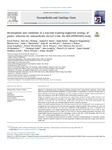Development and validation of a machine learning-supported strategy of patient selection for osteoarthritis clinical trials: the IMI-APPROACH study

Ver/
Use este enlace para citar
http://hdl.handle.net/2183/33427
A non ser que se indique outra cousa, a licenza do ítem descríbese como Creative Commons Attribution-NonCommercial-NoDerivs 4.0 International License (CC-BY-NC-ND 4.0)
Coleccións
- INIBIC- REUMA - Artigos [184]
Metadatos
Mostrar o rexistro completo do ítemTítulo
Development and validation of a machine learning-supported strategy of patient selection for osteoarthritis clinical trials: the IMI-APPROACH studyAutor(es)
Data
2023-12Cita bibliográfica
Widera P, Welsing PMJ, Danso SO, Peelen S, Kloppenburg M, Loef M, Marijnissen AC, van Helvoort EM, Blanco FJ, Magalhães J, Berenbaum F, Haugen IK, Bay-Jensen AC, Mobasheri A, Ladel C, Loughlin J, Lafeber FPJG, Lalande A, Larkin J, Weinans H, Bacardit J. Development and validation of a machine learning-supported strategy of patient selection for osteoarthritis clinical trials: the IMI-APPROACH study. Osteoarthr Cartil Open. 2023 Aug 18;5(4):100406.
Resumo
[Abstract] Objectives. To efficiently assess the disease-modifying potential of new osteoarthritis treatments, clinical trials need progression-enriched patient populations. To assess whether the application of machine learning results in patient selection enrichment, we developed a machine learning recruitment strategy targeting progressive patients and validated it in the IMI-APPROACH knee osteoarthritis prospective study.
Design. We designed a two-stage recruitment process supported by machine learning models trained to rank candidates by the likelihood of progression. First stage models used data from pre-existing cohorts to select patients for a screening visit. The second stage model used screening data to inform the final inclusion. The effectiveness of this process was evaluated using the actual 24-month progression.
Results. From 3500 candidate patients, 433 with knee osteoarthritis were screened, 297 were enrolled, and 247 completed the 2-year follow-up visit. We observed progression related to pain (P, 30%), structure (S, 13%), and combined pain and structure (P + S, 5%), and a proportion of non-progressors (N, 52%) ∼15% lower vs an unenriched population. Our model predicted these outcomes with AUC of 0.86 [95% CI, 0.81–0.90] for pain-related progression and AUC of 0.61 [95% CI, 0.52–0.70] for structure-related progression. Progressors were ranked higher than non-progressors for P + S (median rank 65 vs 143, AUC = 0.75), P (median rank 77 vs 143, AUC = 0.71), and S patients (median rank 107 vs 143, AUC = 0.57).
Conclusions. The machine learning-supported recruitment resulted in enriched selection of progressive patients. Further research is needed to improve structural progression prediction and assess this strategy in an interventional trial.
Palabras chave
Osteoarthritis
Disease progression prediction
Machine learning
Patient selection for clinical trials
Inclusion
Disease progression prediction
Machine learning
Patient selection for clinical trials
Inclusion
Versión do editor
Dereitos
Creative Commons Attribution-NonCommercial-NoDerivs 4.0 International License (CC-BY-NC-ND 4.0)
ISSN
2665-9131






